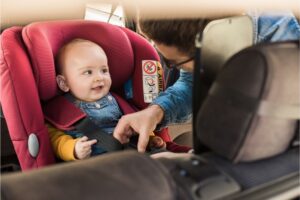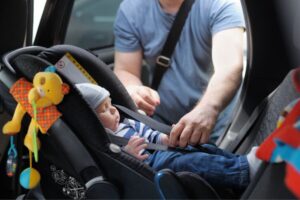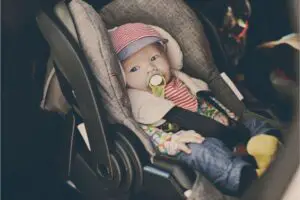Car seats for your child are only helpful if they have been safely secured to your vehicle.
Some seats require the seat belt to secure itself in place, without which you cannot be ensured safety, which is why I am here today to tell you the perfect way of securing the seat straps.
If you are wondering how tight should your child car seat straps be?
When securing the seat straps to your child’s seat, first, make sure you are going to pull the harness snug.
About tightening the straps, if you can get two fingers flat between the collar bones and the body of your child then these should be tight enough.
Some things might affect the tightening among children, for example, the size.
Also, there might be differences in tightening with the same child if the clothing is different, as thicker clothes will make the tightening differ on different days.
Here’s the five common things you should know about tightening the child car seat properly:
- Safety In A Car Seat
- Fitting Shoulder Straps In The Car Seat
- When Seat Straps Are Too Loose
- Car Seat Wiggling
- Mistakes To Avoid In Car Seats
In the article today, I will talk about some aspects of how tight should car seat straps be, its importance and information about car straps and child seats, and some mistakes to avoid with placing your child in the car seat.
Table of Contents
5 Common Things You Should Know About Tightening The Straps On A Car Seat

The straps on a car seat cannot be too tight, only too loose.
Therefore, it is essential for safety to secure them pretty tightly.
The two-finger rule applies in most areas legally as well.
When placing your child inside the car eat, you should buckle up the harness and the chest clip and ensure getting a snug fit.
After this, you should make sure that the straps, as well as the clip, lie flat against the chest of your child or that they are over your child’s hips without any slack.
1. Safety In A Car Seat
Car seats come rear-facing for infants while front-facing for the older kids. These seats are designed to help protect your kids against any kinds of impacts during car crashes.
However, it is important to have your child safely secured in these seats and that the seats are installed correctly and secured properly to the vehicle.
It is also important to remember to always and always buckle your child to the car seat, booster, etc., no matter how short your trip is going to be because that is essential, and anything could happen at any time.
2. Fitting Shoulder Straps In The Car Seat
With rear-facing car seats, the shoulder straps should be coming through the seat slots in the car, or they should be right below the shoulders of your child.
With forward-facing seats, however, these straps should be just above the shoulders of your child.
Properly placing the shoulder straps will help keep your child in the right place and therefore protect them properly because if not fastened correctly.
Your child is at risk of slipping out of the straps and therefore severely damaging themselves.
3. When Seat Straps Are Too Loose
As I mentioned before, seat straps can rarely be too tight, but they can be too loose.
When seat straps are too loose, there is always a danger of the child slipping out of the straps, defeating the purpose of having a child seat to protect your kid from crashes.
Therefore, it is not only important to always remember to buckle your kid in but also to remember to tighten everything properly.
It is also important to remember to not have them extremely tight, as when these are restraining your child like that, the seat straps will be digging inside the child’s body.
This will make it very uncomfortable for the child, making them unable to enjoy the ride, and they might experience pain which you do not want.
It is also essential to make sure that these straps are not loose. If the gap is way too big, the child could get out of position or even get ejected out.
In simple words, the car seat straps should be as snug as a hug, which is self-explanatory as a hug-like snug will be secure enough to keep your child in the proper place.
The snug strap should not be allowing any slack. This should also be lying in a relatively straight position without any sagging.
It shouldn’t be pressing on your child’s flesh or pushing into the body of the child in an unnatural position, as this will be a cause of pain, which your child might also not be able to communicate as they are young, which is an even bigger issue.
So always remember to take precautionary measures.
4. Car Seat Wiggling
Sometimes, parents have reported that the car seats wriggle.
If this happens, this might mean that your car seat is loose and not secured properly, as this shouldn’t be happening, and these should be tightly secured.
Specifically, you should make sure that the seat moves around an inch from any side, not more than that. Normally, there is a LATCH system or the seat belt system used by every car.
If the seat isn’t securing itself properly, the issue might be in the seat, which is not good quality, or you might have made a mistake in securing it.
If the seat isn’t good quality and that is why it isn’t secured, that poses a huge threat, so remember to get a good quality product from a renowned brand.
Moreover, if the seat isn’t secured tightly in place because of not focusing during installation, it is important to know that many real-life accidents occur because of installation errors, and many kids have been harmed.
Thus, it is important to make sure of this.
5. Mistakes To Avoid In Car Seats
As errors during installation are a major cause of cars eats failing to perform their function, because these are built to be very sturdy and safe, it is important to avoid all of the mistakes that might cause these failures.
Here are some of these that you should always keep in mind.
1. Having A Seat Too Loose
You should be aware that in the event of a collision, a child who is placed in a loose seat can either crash in the front seat or the back seat.
The injuries that this might cause will be either in the head or the face. To avoid this from happening, you can test the tightening of the seat.
To do this, grasp the base of the car seat. Like I mentioned before, the seat shouldn’t move more than an inch, and if you can, then it is time to tighten it more.
When installing the seat, always remember to check the manual, which comes from the manufacturer, properly and read all of the instructions.
When using a seat belt to install the car seat, you should first place your knee in the seat, then put all of your weight into it.
With an infant seat, use your arm instead of the knee. Do this until you have tightened the seat belt as much as it is possible. After this, lock the seat belt.
Locking the seat belt is a very obvious step but this is one step that many parents miss, which causes unfortunate events later on.
2. Too Loose Harness
To check if the harness is too loose, you can test it. You can do this after tightening the child into the car seat.
If you are able to pinch the fabric of the harness straps between fingers, this indicates the harness being loose.
The danger this poses is the child easily coming out of this harness in the event of a car crash.
If the child hits any part of the interior, they could get severely injured. In the worst possible case, the child could altogether get ejected from your vehicle.
Therefore, when tightening the harness, remember to do it as tight as possible and to make sure there is no snug or slack when tightening it.
3. The Chest Clip Of The Harness Isn’t Placed Properly
The chest clip of the harness should always be placed at your child’s chest’s center.
This should be despite the armpits of your child. This clip will make sure that the straps of the harness are placed correctly.
If the clip is not in the right place, these straps can easily slip off of the shoulders of the child, and therefore they could get ejected out of the car seat.
Usually, parents move the clip out of place when they get their child out of this seat. Therefore you should remember to check the position every time you’re buckling up the harness.
4. The Rear-Facing Car Seat Isn’t At The Correct Angle
If the rear-facing car seat for your infant isn’t placed at the right angle, the baby’s head which is very disproportionate to the body as well as heavy, can actually fall forwards.
This is extremely dangerous as this might cut off the airway of the baby, making the baby unable to breathe.
This is because babies have very narrow airways, therefore, putting them at risk.
To avoid this, first, check this by testing if it is at the correct angle. You can make sure of this by consulting the instructions that come in the manual.
There will be a correct angle for the rear-facing seat mentioned in the manual and possibly, also a guide on how to adjust this angle.
All the rear-facing seats have built-in angle indicators as well as adjusters, so this shouldn’t be a problem.
Also, most safety seats are to be installed on a flat surface. Most of these will have an adjustable pedestal to deal with this.
If your adjustable pedestal isn’t included, then you should do what technicians usually do during car seat checks.
According to them, they use things like tightly rolled up towels or sections of cut-up swimming pool noodles under the area with the baby’s feet resting.
5. It Is Too Early For Your Baby To Be In The Front-Facing Position
Normally, as a general rule, you shouldn’t have your infant placed in the front-facing seat if they haven’t reached the height and the weight capacity of that yet.
According to AAP, with their older policy, children should remain in the rear-facing position until they turn two. However, with newer recommendations, the specific age has changed.
The reason it is so important to have the baby facing the rear-facing position is that the bones of the baby are still developing and forming.
The back is the strongest part of the baby’s body, and in the event of the crash, this will be able to protect from the impact if the child is placed rear-facing.
The spine will act as the force absorber. However, if the small baby is placed front face, there are dangers involved.
Infants have heads that are much heavier and disproportionate to the body, which is why in the event of a crash; this huge head can actually catapult forward.
The spine of the baby is also underdeveloped, and the head catapulting forward can lead the spine to expose the spinal cord. This can cause paralysis or death.
This is very alarming; therefore with whichever car seat you are using, always remember to check the specific weight and height limitations before changing the baby to be facing to the front area.
Conclusion
It is very important to be aware of how tight should car seat straps be when tightening your child seat inside the car.
In addition, buckling up your child is also something to be taken very seriously, as both the seat being safely secure as well as your child being securely seated are important things to consider for the safety of your child.
The reason I am stressing this so much is the statistics as well as the facts that tell us about how devastating these simple errors in tightening car straps can be, which means buying and using the car seat is in vain.
Whether your child is an infant or an older one, always remember to use a car seat and to buckle it properly regardless of the type of your trip.
On a lighter note, it is a good idea to get a car seat with a very simple installation method because this way, you will find it much easier to safely secure the seat every time you take it out and then reinstall it because you cannot risk not doing so even once.

I am Tahir Azam, and I have been writing amazing articles for TaxiHack for as long as I can remember. I know everything that is to know when it comes to automobiles and is always on top of industry news and developments. While I am not an expert by any means, I pride myself on knowing the ins and outs of many different problems and, of course, their solutions. The articles on our website are some of the best and well-researched content that you will find, and I spend countless hours making sure this remains to be true. This is why I ask you to take your time out and read some of my articles, especially if you find a topic that resonates with you or is something you are looking into. This way, you will find the perfect mix of information and tips on your desired topic. Learn more about Tahir.



